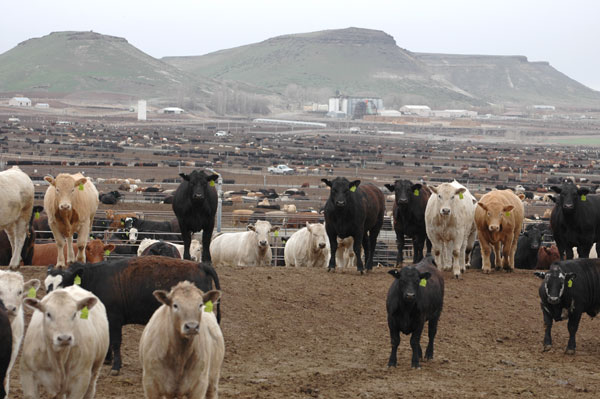Calf and feeder cattle demand continued stronger, despite the sharp downturn in Cattle futures.
March 29, 2019

Cattle futures cast a pall over markets this week, pressured by last week’s Cattle on Feed report indicating more aggressive feedlot placements than expected. The sharp decline and increased volatility in Lean Hog futures added pressure.
Not counting the expiring spot month or newly minted away Mar, Feeder Cattle futures closed an average of $2.55 lower week to week on Friday (47centslower to $5.27 lower).
Even so, cash steers and heifers sold steady to $5 per cwt higher, according to the Agricultural Marketing Service (AMS).
“Feeder cattle markets have generally followed seasonal patterns with calves moving higher since January. Though calf prices typically peak in early April, delayed grass demand may extend the seasonal strength deeper into April,” says Derrell Peel, Extension livestock marketing specialist at Oklahoma State University, in his weekly market comments. Peel adds that feeder-weight cattle (700 pounds and heavier) should begin rising toward a peak in late summer.
“There does appear to be some optimism in the feeder cattle market as the August feeder cattle futures price is trading at an $11 premium to the April contract,” says Andrew P. Griffith, agricultural economist at the University of Tennessee, in his weekly market comments. “The educated guess at this point is that the cash price of feeder cattle will begin a strong advancement to the upside in the coming months to fall more in line with what is expected for live cattle.”
Impacts from the recent bomb cyclone and subsequent prolonged flooding downstream surely will play a role.
“Calf losses this spring will not really become apparent until fall and may possibly be big enough to affect the overall 2019 calf crop,” Peel says. Besides weather-depressed carcass weights and less beef production than originally anticipated, Peel says the recent floods most assuredly increased cattle morbidity and mortality.
“On the crop side, losses of stored grain, hay and other products will have immediate impacts on the producers affected and perhaps on broader markets (see “Flooding jumbles planting outlook” below). Disruptions to transportation may be the biggest impact with truck, rail and river transportation all impacted by the floods and associated damage, and likely to be affected for weeks ahead.”
Jim Robb, senior analyst with the Livestock Marketing Information Center (LMIC) cautions that protracted flooding could increase feed costs and pressure calf and yearling prices.
“If we have a 1993, we have the potential to take corn prices above $6 per bushel,” Robb says. That year, devastating flooding during the growing season followed spring flooding.
“I’m not forecasting that, but to me, there’s more upside in terms of corn and feedstuff cost that would be depressing on calf and yearling prices,” Robb explained, during this week’s BEEF Market Outlook webinar.
Don Close, senior protein analyst at Rabobank AgriFinance, expects to see a seasonal rally in Feeder Cattle futures from the Mar-May low to a high in Aug-Sep. “It might be muted in relationship to a normal seasonal rally, but I think there’s more room left for Feeder Cattle,” he says. Close was also a presenter for the BEEF market webinar.
Fed cattle prices soften
Negotiated cash fed cattle prices were $2-$3 per cwt lower in the Southern Plains at $125-$126 per cwt. on a live basis. Prices in the Northern Plains were mostly $3 lower at mostly $126. Prices in the western Corn Belt were $2 lower at $127-$129. Dressed sales were mostly $2-$3 lower at $206 in Nebraska and $205 in the western Corn Belt.
Week to week on Friday, except for 45 cents higher in the back contract, Live Cattle futures closed an average of $3.08 lower (75 cents to $4.50 lower).
“The cash price plummet was not expected, nor did many in the industry expect April Live Cattle futures to decline more than $2.50 since last Friday,” Griffith says. “The waves, or price fluctuations, of the nearby futures contract should not incite panic among producers or industry participants,” he adds.
“March is generally a month of soft beef demand, which can lead to softer prices in the finished cattle market. Alternatively, April tends to bring optimism to the market from a beef demand standpoint and thus finished cattle. If the cattle market falters in April and May then producers may have a reason for concern.”
Depending on how bullish you are, lost tonnage could still push cash fed cattle prices higher.
For the week ending March 16, average dressed steer weights were 12 pounds lighter than the previous year at 865 pounds, according to USDA’s Actual Slaughter Under Federal Inspection report. Average dressed heifer weights were 17 pounds lighter at 805 pounds.
On the other hand, increasing total meat supplies and packer leverage could mean fed cattle prices reached their seasonal peak last week.
Although he sees the potential for Live Cattle futures to revisit recent highs or more in April, Close believes the momentum of the winter-spring rally is behind us.
“From current levels, I would be much more interested in selling rallies than I would be in in looking for opportunities to buy breaks in fed cattle,” Close says.
Choice wholesale beef value was $3.05 lower week to week on Friday at $226.04 per cwt. Select was 25 cents higher at $218.89.
Griffith points out this was the first decline for Choice boxed beef cutout prices in eight weeks; prices increased $15 per cwt along the way.
About the Author(s)
You May Also Like


.png?width=300&auto=webp&quality=80&disable=upscale)

.png?width=300&auto=webp&quality=80&disable=upscale)
